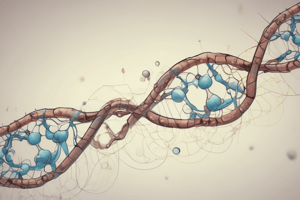Podcast
Questions and Answers
What is the primary difference between transcription and DNA replication?
What is the primary difference between transcription and DNA replication?
- The product is an RNA molecule in transcription. (correct)
- Transcription occurs in the cytoplasm, while DNA replication occurs in the nucleus.
- The process of transcription is faster than DNA replication.
- The product is a protein molecule in transcription.
What is the role of RNA polymerase in the transcription process?
What is the role of RNA polymerase in the transcription process?
- It acts as a template for DNA replication.
- It translates RNA into proteins.
- It breaks down RNA molecules into nucleotides.
- It separates the DNA strands and assembles nucleotides into a complementary RNA strand. (correct)
What determines where RNA polymerase binds to DNA during transcription?
What determines where RNA polymerase binds to DNA during transcription?
- Specific base sequences in promoter regions. (correct)
- The type of RNA molecule being produced.
- The structure of the DNA molecule.
- The sequence of nucleotides on the DNA strand.
What is the result of a single gene being expressed through transcription?
What is the result of a single gene being expressed through transcription?
What is the function of the template strand in transcription?
What is the function of the template strand in transcription?
What terminates the transcription process?
What terminates the transcription process?
Flashcards are hidden until you start studying
Study Notes
Transcription
- A single DNA molecule can contain hundreds or thousands of genes, but only those being expressed are copied into RNA at a given time.
- Transcription is the process of copying a base sequence from DNA to RNA.
- The product of transcription is an RNA molecule, unlike DNA replication which produces a duplicate of DNA.
- In transcription, segments of DNA serve as templates to produce complementary RNA molecules.
The Role of RNA Polymerase
- RNA polymerase is the enzyme responsible for carrying out transcription.
- RNA polymerase binds to DNA and separates the DNA strands.
- It uses one strand of DNA as a template to assemble nucleotides into a complementary strand of RNA.
- The ability to quickly copy a DNA sequence into RNA enables a single gene to produce hundreds or thousands of RNA molecules.
Initiation and Termination of Transcription
- RNA polymerase binds to specific regions of DNA called promoters, which have unique base sequences.
- Promoters are regions of DNA that can bind to RNA polymerase, indicating where to start transcription.
- Other regions of DNA cause transcription to stop when an RNA molecule is completed, indicating where to terminate transcription.
Studying That Suits You
Use AI to generate personalized quizzes and flashcards to suit your learning preferences.



